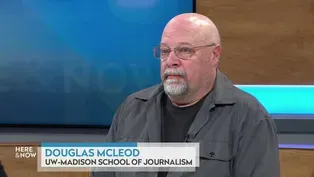Here and Now
Dr. Julie Owen on Police, Sedatives and 'Excited Delirium'
Clip: Season 2200 Episode 2243 | 6m 54sVideo has Closed Captions
Dr. Julie Owen on the "excited delirium" diagnosis and forcible injection of sedatives.
Medical College of Wisconsin professor and psychiatrist Dr. Julie Owen explains the disputed diagnosis of "excited delirium" and its use when detained people are forcibly injected with sedatives.
Here and Now
Dr. Julie Owen on Police, Sedatives and 'Excited Delirium'
Clip: Season 2200 Episode 2243 | 6m 54sVideo has Closed Captions
Medical College of Wisconsin professor and psychiatrist Dr. Julie Owen explains the disputed diagnosis of "excited delirium" and its use when detained people are forcibly injected with sedatives.
How to Watch Here and Now
Here and Now is available to stream on pbs.org and the free PBS App, available on iPhone, Apple TV, Android TV, Android smartphones, Amazon Fire TV, Amazon Fire Tablet, Roku, Samsung Smart TV, and Vizio.
Providing Support for PBS.org
Learn Moreabout PBS online sponsorshipmuch.
Thanks for your work.
Thank you.
An investigation by the AP and PBS frontline revealed police and medics using injected sedatives to de-escalate people who have been deemed to have something called excited delirium.
>> We've now come to understand that excited delirium is a deeply flawed concept in many cases, the definition of excited delirium is built on racial stereotypes and probably more fundamentally, excited.
Delirium was a concept that, in many of these cases, served to shift the focus from the actions of the first responders.
Restraint or chemical sedation by the police or by EMS to the individual for using methamphetamine, for engaging in criminal activity, for, in some cases, suffering from mental health emergencies.
>> The use of medications is part of an excited delirium protocol in some departments to render the person compliant.
This is often in combination with stun guns and pinning subjects face down, but the combination can be fatal.
It happened to a man in Eau Claire County, as described in the investigative reporting excited high pain tolerance and superhuman strength, is a controversial and disputed diagnosis and should not be used to justify use of force and medication given.
That's according to our next guest psychiatrist, Doctor Julie Owen from the Medical College of Wisconsin.
And doctor, thanks for joining us.
>> Why do you say that excited delirium is a disputed diagnosis .
to be described in the 1980s, and that was in conjunction with , a rising cocaine use and there are very few, professional medical organizations that delirium as a diagnosis.
And without that recognition and without that consensus of the medical community, there's been a lack of true diagnostic criteria that folks agree on, when using this term, which has called its use into dispute.
>> So if it's if it's not excited delirium, what are police and first responders and medics responding to in the field that that then have them using these injected sedatives.
>> So oftentimes, as an individual who might be described as displaying features of, what has been come to known as be known as excited delirium, they will look extremely agitated and, they will potentially be behaving in a bizarre manner, the literature that has looked at this, syndrome has described, things like increased pain tolerance, the individual looking sweaty, the individual breathing rapidly.
An individual who looks like they're they don't really get tired despite a lot of physical exertion.
And sometimes, the literature also describes individuals who are not necessarily complying with law enforcement official orders.
And or being inappropriately clothed in your research, what did you find about the outsized diagnosis of this excited delirium in black or brown police subjects?
Usually there's a, a skewing of the use of this term with, young men and young men of color, and young men of color, who probably at a later phase of examination, are found to be utilizing some sort of, what we call sympathomimetic or a stimulant like substance.
>> So the front line investigation is narrowed in on the use of injected drugs like ketamine by police and medics.
What's your view of that?
Use >> I work in the hospital setting.
In the hospital setting, if an individual presents with agitated Bryan, typically the best accepted practice is as a physician to evaluate that person and try to determine what is the most likely cause of that person's agitation.
And medications are used as a tool then to treat and relieve that person of that agitated state.
So the use of medications is in and of themselves, is not necessarily problematic.
It's the use of a medication with oftentimes very incomplete data and with differing protocols, and dosing.
And again, sort of starting with that, not truly a medical diagnostic term, to sort of drive the intervention or the choice of the intervention that seems to be problematic in these cases.
>> How troubling is it to you that excited delirium might be used as a justification for use of force or injections of ketamine?
>> It is troubling, and again, I think, you know, as a physician and, and as a physician who practices in solely emergent or acute settings, this sort of case is hard for somebody like myself, to try to get to the bottom of and when you have folks who don't have the same amount of clinical training, sort of throwing out terms that sound like diagnoses to then drive interventions, with questionable safety involved and, and of course, when these interventions result in lethal outcomes, when really that's probably not necessary.
That is disturbing.
>> You say that it is imperative to find consensus bias among medical professionals around the diagnosis of excited delirium.
Has that yet been found?
That consensus?
No And are more people like yourself talking about it?
again, my practice clinically, is working shoulder to shoulder with emergency medicine physicians and that sort of cross specialty collaboration, and, collaboration of expertise in this space.
I think that's what's necessary to really, find again, consensus.
But a real clear sense of what it is that we're trying to accomplish with utilizing terms like this or trying to catch summarize clinical presentations like
Douglas McLeod on Impacts of Pro-Palestinian Campus Protests
Video has Closed Captions
Douglas McLeod on media coverage about and political implications of campus protests. (6m 21s)
Here & Now opening for May 10, 2024
Video has Closed Captions
The introduction to the May 10, 2024 episode of Here & Now. (1m 31s)
Jane Graham Jennings on Funding for Crime Victim Services
Video has Closed Captions
Jane Graham Jennings on a funding drop limiting capacity to provide aid to crime victims. (5m 48s)
William Gardner on the Ho-Chunk Nation and Cannabis Laws
Video has Closed Captions
William Gardner on the Ho-Chunk Nation voting to decriminalize cannabis on tribal lands. (5m 26s)
Providing Support for PBS.org
Learn Moreabout PBS online sponsorship














